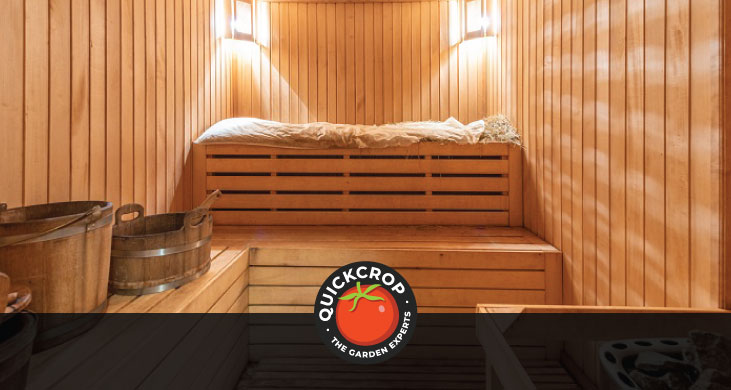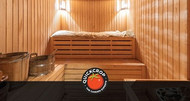Sauna Safety Tips

The sauna can be a terrific place to unwind, rejuvenate or socialise. It’s a place you want to retreat to so you can take your mind off daily stresses. Having said that, you should still be aware of certain safety principles to keep in mind. The last thing you want is a bad experience putting you off an activity that should be spiritually enriching.
Drink Plenty of Water!
Sweat is the body’s way of regulating temperature. It makes sense then that in a traditional sauna environment, you will sweat a lot. It’s common for a single sauna session to result in roughly a pint of sweat being lost. When you sweat a lot, you become more dehydrated. It’s a good idea therefore to drink plenty of water when you are planning a session in the sauna (ideally you should hydrate well a couple of hours before you enter). Rehydrating after a sauna session is also important (although pre-hydrating is always preferable if you have to choose between the two). Dehydration can creep up on a person, even if they’re not feeling particularly thirsty.
Somewhat related to this tip is the following…
Avoid Alcohol
If you’re sauna-ing it up with friends, it may be tempting to have a few beers while you’re at it. Here’s an area where you should be careful. Aside from the fact that alcohol can exacerbate dehydration, it can also lead to clumsiness, accidents and a general lack of common sense.
Statistics relating to sauna deaths in Finland (don’t panic, a certain amount of deaths are almost inevitable when roughly three million saunas are in use) showed that a very high percentage had alcohol as a contributing factor. There’s a higher risk of slips and falls, and a much higher possibility of hypotension or fainting spells.
Now if you’re going to stick to a sensible bottle or two, then it might not be the most dangerous thing you do that day, but being sensible with alcohol is often easier said than done. Our conclusion is that alcohol and saunas don’t mix.
Don’t Push the Temperature too High
Many experts will put the ideal sauna temperature at between 70 and 90 °C, but personal mileage can vary; it’s all about your own comfort level and where you find the most benefit.
It can be a good idea to install or include a gauge thermometer in your sauna (as well as a hygrometer which measures humidity). This way you can be assured that it’s not overheating, as well as giving you a good idea of what your ideal comfort zone is. Electrically heated saunas give you more precise control over temperature, but with wood fired saunas it can be a good idea to monitor and make sure that it isn’t getting too hot or uncomfortable.
Ventilation
Adequate airflow is very important for a safe and comfortable sauna experience. If there is a problem with ventilation it can allow carbon monoxide to build up to potentially harmful levels, result in staler air or make the environment uncomfortable. Effective ventilation will also ensure that fresh air will mix with the warmed air in a way that avoids cold pockets or uneven heat.
Ventilation methods will depend on the type of sauna you have and how it is heated (e.g. wood fired will obviously produce more smoke, but will also tend to have a chimney or flue pipe). Consult the manual or speak to your installer to ensure that ventilation is operating as it should. Ventilation can be mechanical or gravitational (natural). Modern indoor saunas are more likely to ventilate mechanically, but outdoor saunas (such as barrel types) rely on gravitational ventilation. With the latter method, intake of air should always be below the point where air is vented outwards.
Short Sessions
It’s recommended to keep sauna sessions to about 15-20 minutes at a time. That doesn’t necessarily mean only 15 minutes a day: indeed, many people will take a break after one short session and then go back for another. You can use that break period to cool down, read a book or maybe even plunge into some icy water (for the true sauna connoisseur). The body is less able to deal with more prolonged periods of high temperature, and can become stressed in various ways: nausea, faintness or hypothermia are possible risks.
If you’re new to using a sauna, it’s a good idea to start with shorter sessions and gradually increase the time you spend in there, as your body gets used to the sensation.
Avoid Lying Down
Saunas are obviously a very relaxing environment - that is one of their great strengths. You should be careful though not to take relaxation to its logical conclusion. Lying back or lying down on a bench can make it more likely that you nod off. If you’re using the sauna alone this can be potentially treacherous, as no-one will be there to rouse you from your slumber. Remember that spending longer than 20 minutes in a sauna at a time can increase the risk of unpleasant side effects like nausea, skin burns or irritation.
Lying down can make it harder for the body to regulate temperature, another pitfall to be aware of. Quickly going from lying down to a sitting or standing position can also be slightly treacherous in very hot conditions, as the change in blood pressure can cause pronounced light-headedness or even a brief fainting spell.
Heart Conditions
If you have any pre-existing medical conditions (such as high blood pressure, angina or other heart conditions,asthma etc), you should consult your doctor or a health professional before using a sauna. Pregnant women should also avoid sauna use.
Remove Jewellery
It’s a good idea to remove jewellery whengoing for a session. Certain jewellery materials have high heat conductivity and can potentially cause skin burns. Check for earrings, watches, necklaces or rings (or imagine that you’re going through a baggage check and you don’t want to be delayed).
The issue of glasses and contact lenses is also often raised. Some people think that there’s no real issue with lenses from experience. A dry heat environment can however cause your eyes to dry out, which often leads to an uncomfortable sensation. With glasses, one thing to be aware of is that high temperatures may affect the protective coating on the lens of the glasses (if indeed you have one).
Bring a Towel
Sauna benches can be very hot to the touch, so it’s a good idea to have a towel to sit on. It will act as a protective barrier between your skin and the hot surface. This is not only a safety tip; it will also make your sauna experience more comfortable and immersive, as you won’t be overly conscious of one part of your body being hotter.
Use a Ladle
Pouring water on the heated sauna stones is an important part of the traditional sauna experience. The resulting steam is known as ‘löyly’ (or ‘leil’ in Estonia). The Finns believe that without löyly, there is no sauna. With löyly, however, comes steam, and steam can hurt you if you’re too close to it. When adding the water, make sure to use a long-handled ladle. This will keep your hands clear of the initial burst of steam. For that extra bit of protection you could also wear wool felt gloves.
Listen to your Body
Our body has a habit of letting us know when conditions are unfavourable. Don’t dismiss telltale signs of discomfort such as lightheadedness, chest tightness, difficulty breathing, or skin irritation. The sauna is meant to be a pleasant environment, and while it can take a bit of getting used to at first, it should not be treated like an endurance test!
